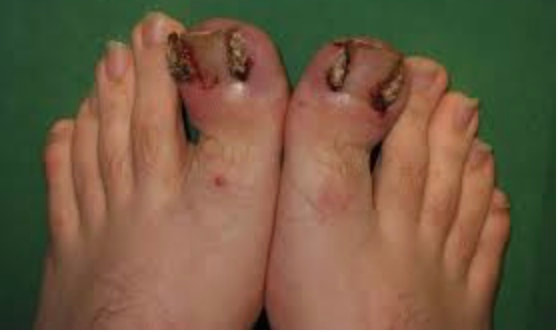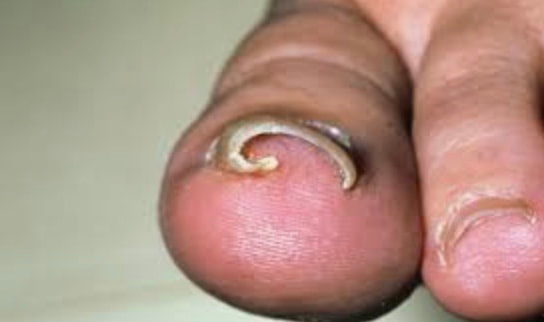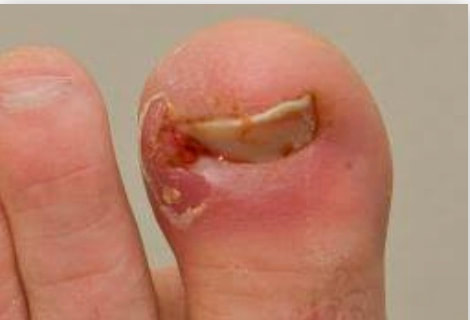INGROWN NAILS - PARONYCHIA
What's the Problem?An ingrown nail occurs when a portion of a toenail on either side of the toe turns downward and presses into the skin. Nails normally are nearly flat, with just a slight arcing downward at the borders. When the border of the nail is turned downward, it begins to injure the skin.
How Does It Feel?Patient's usually feel pressure and eventually pain, as the hard and sharp nail edge creates further injury. Shoes which apply pressure to the toe increase the pain. If an infection develops, the pain becomes intolerable.
Let's Do A TestAn ingrown nail is identified by the doctor's physical exam. If an infection has developed, the doctor may send a sample of the drainage to a lab, to identify what bacteria has caused the infection and which antibiotics will most easily cure the infection.
How Did This Happen?A progression of events occurs. Routinely cutting the nails improperly, down at an angle instead of straight across, is the most common cause of ingrown nails. Wearing narrow or pointed shoes can apply enough pressure to a normal nail to turn the nail edge downward. Once the nail matrix, the tissue where the nail grows from, gets injured in this way, it continues to produce a nail edge that is more vertical than horizontal. From this abnormal nail growth, the nail edge applies mild pressure on the skin over a long period of time. The skin at the nail edge thickens and becomes hardened. You may begin to notice an enlargement or swelling of the skin around the nail edge. The condition can progress as a result of other factors. These factors include: pressure from a tight or pointed shoe, injury such as stubbing a toe,, excessive wetness, either from perspiration or application of ointments or creams or improper cutting of nails. If these factors come into play, the possibility increases that the nail edge can then penetrate the skin just like a knife and cause an infection. The skin at the nail edge becomes reddened and swollen. You may notice drainage or pus from the area and the pain becomes intolerable.
What Can I Do For It?In mild cases, where no infection is present, pain relief can be obtained by applying a standard moisturizing cream to the nail edge and covering with a bandaid. This softens the hard skin and often provides temporary pain relief. In more advanced cases, where redness or obvious infection is present, seek the attention of a doctor.
What Will My Doctor Do For It?In the most minor cases, the podiatrist will simply cut the nail to shorten it, and show you how to cut the nail in the future to prevent in growing of the nail again. (See below for instructions on proper nail cutting). In more severe cases, but not those in which an infection hasn't developed, the podiatrist may gently remove the ingrown portion of the nail. This affords considerable relief, but is temporary. After a few weeks, when the nail grows long again, it will again grow in. In cases where the nail has grown in repeatedly, or more critically, when the nail edge has penetrated the skin and caused an infection, the podiatrist will perform a minor procedure called an Ingrown Nail Correction or Matricectomy. The podiatrist will gently numb your toe, reshape the nail edge and finally apply a medicine which will in most cases permanently prevent the nail edge from growing improperly again.
Can I Prevent It From Happening Again?
What's the Problem?An ingrown nail occurs when a portion of a toenail on either side of the toe turns downward and presses into the skin. Nails normally are nearly flat, with just a slight arcing downward at the borders. When the border of the nail is turned downward, it begins to injure the skin.
How Does It Feel?Patient's usually feel pressure and eventually pain, as the hard and sharp nail edge creates further injury. Shoes which apply pressure to the toe increase the pain. If an infection develops, the pain becomes intolerable.
Let's Do A TestAn ingrown nail is identified by the doctor's physical exam. If an infection has developed, the doctor may send a sample of the drainage to a lab, to identify what bacteria has caused the infection and which antibiotics will most easily cure the infection.
How Did This Happen?A progression of events occurs. Routinely cutting the nails improperly, down at an angle instead of straight across, is the most common cause of ingrown nails. Wearing narrow or pointed shoes can apply enough pressure to a normal nail to turn the nail edge downward. Once the nail matrix, the tissue where the nail grows from, gets injured in this way, it continues to produce a nail edge that is more vertical than horizontal. From this abnormal nail growth, the nail edge applies mild pressure on the skin over a long period of time. The skin at the nail edge thickens and becomes hardened. You may begin to notice an enlargement or swelling of the skin around the nail edge. The condition can progress as a result of other factors. These factors include: pressure from a tight or pointed shoe, injury such as stubbing a toe,, excessive wetness, either from perspiration or application of ointments or creams or improper cutting of nails. If these factors come into play, the possibility increases that the nail edge can then penetrate the skin just like a knife and cause an infection. The skin at the nail edge becomes reddened and swollen. You may notice drainage or pus from the area and the pain becomes intolerable.
What Can I Do For It?In mild cases, where no infection is present, pain relief can be obtained by applying a standard moisturizing cream to the nail edge and covering with a bandaid. This softens the hard skin and often provides temporary pain relief. In more advanced cases, where redness or obvious infection is present, seek the attention of a doctor.
What Will My Doctor Do For It?In the most minor cases, the podiatrist will simply cut the nail to shorten it, and show you how to cut the nail in the future to prevent in growing of the nail again. (See below for instructions on proper nail cutting). In more severe cases, but not those in which an infection hasn't developed, the podiatrist may gently remove the ingrown portion of the nail. This affords considerable relief, but is temporary. After a few weeks, when the nail grows long again, it will again grow in. In cases where the nail has grown in repeatedly, or more critically, when the nail edge has penetrated the skin and caused an infection, the podiatrist will perform a minor procedure called an Ingrown Nail Correction or Matricectomy. The podiatrist will gently numb your toe, reshape the nail edge and finally apply a medicine which will in most cases permanently prevent the nail edge from growing improperly again.
Can I Prevent It From Happening Again?
- Cutting Nails Properly to Prevent Ingrown Nails



